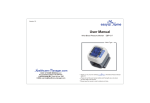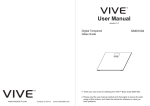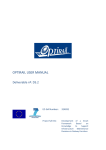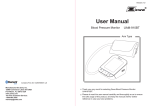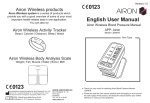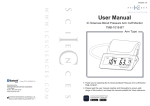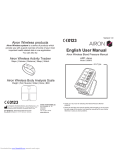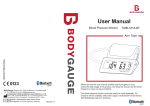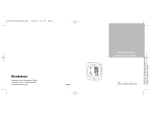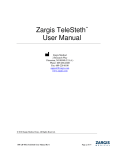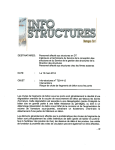Download User Manual
Transcript
User Manual Digital Blood Pressure Monitor version:1.0 DMD1001 Arm Type Thank you very much for selecting VIVE™ Digital Blood Pressure Monitor DMD1001 WWW.VIVEHEALTH.COM Contact us 24/7 at www.vivehealth.com Please read the user manual carefully and thoroughly to ensure the safe usage of this product, and retain the manual for reference in case you have problems. CATALOG CATALOG Table of Contents INTRODUCTION...................................................................................................................2 General Description Safety Information LCD Display Signal Monitor Components BEFORE YOU START...........................................................................................................6 The Choice of Power Supply Installing and Replacing the Batteries Measurement Principle Setting Date, Time and Measurement Unit MEASUREMENT...................................................................................................................9 Tie the Cuff Select the User Start the Measurement DATA MANAGEMENT..........................................................................................................12 Recall the Records Delete the Records INFORMATION FOR USER................................................................................................15 Tips for measurement Maintenances ABOUT BLOOD PRESSURE..............................................................................................17 What are systolic pressure and diastolic pressure? What is the standard blood pressure classification? Why does my blood pressure fluctuate throughout the day? Why the blood pressure I get from the hospital is different from home? If the result is the same if measuring on the right arm? TROUBLESHOOTING.........................................................................................................19 SPECIFICATIONS...............................................................................................................20 AUTHORIZED COMPONENT ............................................................................................21 CONTACT INFORMATION..................................................................................................21 COMPLIED STANDARDS LIST...........................................................................................22 FCC STATEMENT...............................................................................................................22 EMC GUIDANCE.................................................................................................................23 1 INTRODUCTION INTRODUCTION General Description CAUTION Thank you for selecting VIVE™ upper arm Blood Pressure Monitor (DMD1001). The monitor features blood pressure measurement, pulse measurement, and result storage. The design provides you with two years of reliable service. Readings taken by the DMD1001 are equivalent to those obtained by a trained observer using the cuff and stethoscope auscultation method. This manual contains important safety and care information, and provides step-by-step instructions for using the product. Read the manual thoroughly before using the product. Features: 2.4x1.6in Digital LCD display Maximum 60 records per each user 3rd technology: Measuring during inflation (Most up to date technology in the world) Safety Information The below signs might be in the user manual, labeling or other component. They are the requirement of standard and using. Symbol for “THE OPERATION GUIDE MUST BE READ” Symbol for “MANUFACTURER” Symbol for “SERIAL NUMBER” Symbol for “DIRECT CURRENT” Symbol for “MANUFACTURE DATE” 2 Symbol for “TYPE BF APPLIED PARTS” Symbol for “ENVIRONMENT PROTECTION - Waste electrical products should not be disposed of with household waste. Please recycle where facilities exist. Check with your local authority or retailer for recycling advice” This device is intended for adult use only. This device is intended for non-invasive measuring and monitoring of arterial blood pressure. It is not intended for use on extremities other than the arm or for functions other than obtaining a blood pressure measurement. Do not confuse self-monitoring with self-diagnosis. This unit allows you to monitor your blood pressure. Do not begin or end medical treatment. Consult your physician for treatment or advice. If you are taking medication, consult your physician to determine the most appropriate time to measure your blood pressure. Never change a prescribed medication without consulting your physician. If the cuff pressure exceeds 40kPa (300 mmHg), the unit will automatically deflate. Should the cuff not deflate when pressure exceeds 40 kPa (300 mmHg), detach the cuff from the arm and press the START/STOP button to stop inflation. To avoid measurement errors, carefully read this manual before using the product. The equipment is not AP/APG equipment and not suitable for use in the presence of a flammable anesthetic mixture with air of with oxygen or nitrous oxide. The operator shall not touch output of batteries and the patient simultaneously. To avoid measurement errors, please avoid the condition of strong electromagnetic field radiated interference signal or electrical fast transient/burst signal when using the AC adaptor. The user must check that the equipment functions safely and see that it is in proper working condition before being used. Please use ACCESSORIES and detachable parts specified/ authorized by MANUFACTURE. Otherwise, it may cause damage to the unit or danger to the user/ patients. Manufacturer will make available on request circuit diagrams, component parts list, etc. This unit is not suitable for continuous monitoring during medical emergencies or operations. Otherwise, the patient’s arm and fingers will become anesthetic, swollen and even purple due to a lack of blood. Please use the device under the environment which was provided in the user manual. Otherwise, the performance and lifetime of the device will be impacted and reduced. During using, the patient will contact with the cuff. The materials of the cuff have been tested and found to comply with requirements of ISO 10993-5:2009 and ISO 10993-10:2010. It will not cause any potential allergic reaction or contact injury. The device doesn’t need to be calibrated in two years of reliable service. Please dispose of ACCESSORIES, detachable parts, and the ME EQUIPMENT according to the local guidelines. When the device was used to measure patients who have common arrhythmias such as atrial or ventricular premature beats or arterial fibrillation, the best result may occur deviation. Please consult your physician about the result. The device is contraindicated for any female subject who may be suspected of, or is pregnant. Besides provided inaccurate readings, the effects of this device on the fetus are unknown. When using this device, please pay attention to the following situation which may interrupt blood flow and influence blood circulation of the patient, thus cause harmful injury to the patient: Too frequent and consecutive multiple measurements; The application of the cuff and its pressurization on any arm where intravascular access or therapy, or an arterio-venous (A-V) shunt, is present; Inflating the cuff on the arm on the side of a mastectomy. Do not apply the cuff over a wound, otherwise it can cause further injury. Do not inflate the cuff on the same limb which other monitoring ME EQUIPMENT is applied around simultaneously, because this could cause temporary loss of function of those simultaneously-used monitoring ME EQUIPMENT. Using it in case to result in prolonged impairment of the circulation of the blood of the PATIENT. Don’t kink the connection tube, otherwise, the cuff pressure may continuously increase which can prevent blood flow and result in harmful injury to the PATIENT. The device has been evaluated clinically used manual cuff/stethoscope auscultations the reference. Blood pressure measurements determined with this device are equivalent to those obtained by a trained observer using the cuff/stethoscope auscultatory method, within the limits prescribed 3 INTRODUCTION INTRODUCTION LCD display signal Monitor Components CUFF AIR HOSE AIR CONNECTOR PLUG MEM BUTTON SET BUTTON START/STOP BUTTON SYMBOL kPa mmHg 4 DESCRIPTION EXPLANATION Systolic blood pressure High pressure result Diastolic blood pressure Low pressure result Pulse per minute Beats per minute, BPM Deflating Air in cuff is deflating Memory The displayed measurement values stored in the memory. kPa Measurement Unit of the blood pressure mmHg Measurement Unit of the blood pressure Low battery Batteries are low and need to be replaced Arrhythmia Irregular heartbeat Grade The grade of the blood pressure Current Time Month/Day/Year, Hour/Minute User 1 Start measurement and save the results for User 1 Start measurement and save the results for User 2 User 2 LCD DISPLAY Component list of pressure measuring system 1 Cuff 2 Air pipe 3 PCBA 4 Pump 5 Valve List BATTERY COMPARTMENT 1.Blood Pressure Monitor (TMB-1491-D) 2.Cuff (Type BF applied part) (22~32cm) 3. 4×AAA batteries 4.User manual 5 BEFORE YOU START BEFORE YOU START Measurement Principle The Choice of Power Supply This product uses the Oscillometric Measuring method to detect blood pressure. 1.Battery powered mode: Before every measurement, the unit establishes a “zero pressure” equivalent to the air 2.AC adaptor powered mode: oscillations generated by beat-to-beat pulsatile, which is used to determine the systolic and diastolic pressure, and also pulse rate. 6VDC 4×AAA batteries pressure. Then it starts inflating the arm cuff, meanwhile, the unit detects pressure 6V 1A (Please use the recommended AC adaptor model). (Not Included) pulse waves to mean time interval then calculates standard deviation. The device will Please unplug the adaptor when not in use. The device also compares the longest and the shortest time intervals of detected AC adaptor (Not Included) CAUTION In order to get the best effect and protect your monitor, please use the right battery and special power adapter which complies with U.S. safety standard. Installing and Replacing the Batteries • Open the battery cover. • Install the batteries by matching the correct polarity, as shown. • Replace the cover. Replace the batteries when: (See Below) The shows The display dims The display does not light up CAUTION 6 Remove batteries if the device is not likely to be used for some time. The old batteries are harmful to the environment, so please DO NOT dispose with other daily trash. Remove the old batteries from the device and follow your local recycling guidelines. Do not dispose of batteries in fire. Batteries may explode or leak. display a warning signal with the reading to indicate the detection of irregular heartbeat when the difference of the time intervals is over 25%. Setting Date, Time and Measurement Unit It is important to set the clock before using your blood pressure monitor, so that a time stamp can be assigned to each record that is stored in the memory. (The setting range of the year: 2014—2054 time format:12 H) 1.When the monitor is off, hold pressing “SET” for 3 seconds to enter the mode for year setting. Or when the monitor is off, press “SET” button shortly, it will display the time. Then hold pressing “SET” button to enter the mode for year setting. 2.Press the “MEM” to change the [YEAR].Each press will increase the numeral by one in a cycling manner. 3.When you get the right year, press “SET” to set down and turn to next step. 7 BEFORE YOU START 4.Repeat step 2 and 3 to set the [MONTH] and [DAY]. MEASUREMENT 5.Repeat step 2 and 3 to set the [HOUR] and [MINUTE]. Applying the cuff 1.Apply the cuff on your upper arm. Make sure the position of the tube is off-center; toward the inner side of arm in line with the little finger. 2.The cuff should be snug but not too tight. You should be able to insert one finger between the cuff and your arm. 2~3cm 6.Repeat step 2 and 3 to set the [UNIT]. 3.Sit comfortably with your test arm resting on a flat surface. 4.Patients with Hypertension: The middle of the cuff should be at the level of the right atrium of the heart; Before starting measurement, please sit comfortably with legs uncrossed, feet flat on the floor, back and arm supported. 8 S TA R T S TO P 7.After the unit is set, the LCD will display “done” first, then display all the settings you have done and then it will turn off. Resting For 5 minutes before measuring. Wait at least 3 minutes between measurements. This allows your blood circulation to recover. For a meaningful comparison, try to measure under similar conditions. For example, take daily measurements at approximately the same time, position of upper arm, or as directed by a physician. 9 MEASUREMENT MEASUREMENT Select the User Start the Measurement 1.When the monitor is off, press SET button to turn on the monitor. Press SET button again to select the User ID between User 1 and User 2. 1.After correctly positioning the cuff and selecting the User ID, press the “START/STOP” button to turn on the monitor when the LCD is off, and it will finish the whole measurement. (Take User 1 for example.) LCD display START STOP Adjust the zero. 2.When the desired User ID is shown, press START/STOP button to confirm and the monitor will turn off. (Take User 1 for example.) Inflating and measuring. Display and save the results. START STOP 2.Press the “START/STOP” to power off, otherwise it will turn off within 1 minute. 10 START STOP 11 DATA MANAGEMENT DATA MANAGEMENT Recall the Records 3. If you want to check another user’s records, press START/STOP button to turn off the monitor when it is in the memory recall mode. Then press “SET” button to turn on the monitor, press “SET” button again to select the desired user ID, when it displays your desired user ID, press START/STOP button to confirm, the LCD will turn off. Then press “MEM” button to review the selected user’s records. 1. When the monitor is off, press the “MEM” to show the average value of the latest three records for the selected user. (Take User 1 for example.) 2. Press “MEM” button or “SET” button to rotate the history records. Press “MEM” button to review the record from the latest to the oldest. Press “SET” button to review the record from the oldest to the latest. UP DOWN The date and time of the record will be shown alternately. The current No. is No 2. The corresponding date is January 1st. 4. If there is no record, the following display will be shown. (Take User 1 for example.) The corresponding time is P.M. 10:08. CAUTION The most recent record (1) is shown first. Each new measurement is assigned to the first (1) record. All other records are pushed back one digit (e.g., 2 becomes 3, and so on), and the last record (60) is dropped from the list. 12 13 INFORMATION FOR USER DATA MANAGEMENT Tips for Measurement Delete the Records If you did not get the correct measurement, you can delete all results by following the steps below. It can cause inaccuracy if the measurement is taken in the following circumstances. 1.Hold pressing “MEM” and “SET” button for 3 seconds when the monitor is in the memory recall mode, the flash display “dEL ALL” will be shown. Within 1 hour after dinner or drinking Immediate measurement after tea, coffee, smoking Within 20 minutes after taking a bath When talking or moving your fingers 2.Press “SET” button to confirm deleting and the LCD will display “dEL dOnE”, and then turn off. 3.If you don’t want to delete the records, press “START/STOP” button to escape. 14 START STOP In a very cold environment When you need to urinate 15 INFORMATION FOR USER ABOUT BLOOD PRESSURE What is systolic pressure and diastolic pressure? Maintenance In order to get the best performance, please follow the instructions below. When ventricles contract and pump blood out of the heart, the blood pressure reaches its maximum value in the cycle, which is called systolic pressure. When the ventricles relax, the blood pressure reaches its minimum value in the cycle, which is called diastolic pressure. Systolic Diastolic press relax blood discharging artery blood entering vein What is the standard blood pressure classification? Keep monitor in a dry place and avoid direct sunlight. Keep away from water. The chart on the right is the standard blood pressure classification published by American Heart Association (AHA). AHA Home Guideline for Upper Limit of Normal BP SYS 135 mm Hg DIA 85 mm Hg Avoid intense shaking, collision, and shock. Avoid harsh environments. This chart reflects blood pressure categories defined by American Heart Association. Blood Pressure Category Systolic mmHg (upper#) Diastolic mmHg (lower#) less than 120 and less than 80 Prehypertension 120-139 or 80-89 High Blood Pressure (Hypertension) Stage 1 140-159 or 90-99 160 or higher or 100 or higher Higher than 180 or Normal High Blood Pressure (Hypertension) Stage 2 Hypertensive Crisis (Emergency care needed) Higher than 110 CAUTION Use a damp cloth to wipe down monitor. DO NOT use corrosive cleaning chemicals, as they may damage device. Do not attempt to clean the reusable cuff with water and never immerse the cuff in water. CAUTION Please use ACCESSORIES and detachable parts specified/ authorized by MANUFACTURE. Otherwise, it may cause damage to the unit or danger to the user/patients. The device doesn’t need to be calibrated in two years of reliable service. Please dispose of ACCESSORIES, detachable parts, and the ME EQUIPMENT according to the local guidelines. If you have any problems with this device, such as setting up, maintaining or using, please contact [email protected]. Don’t open or repair the device by yourself. Please report to vivehealth.com if any unexpected operation or events occur. Please use a soft cloth to clean the whole unit. Don’t use any abrasive or volatile cleaners. 16 Only a physician can tell your normal BP range. Please contact a physician if your measuring result falls out of the range. Kindly note that only a physician could tell whether your blood pressure value has reached a dangerous point. Irregular Heartbeat Detector This Blood Pressure Monitor is equipped with an intelligent function of Irregular Heartbeat (IHB) Detector. During each measurement, this equipment records the heartbeat intervals and works out the standard deviation. If the calculated value is larger than or equal to 15, this equipment will light up the IHB symbol on the screen when displaying the measuring result. CAUTION The appearance of the IHB icon indicates that a pulse irregularity consistent with an irregular heart-beat was detected during measurement. Usually this is NOT a cause for concern. However, if the symbol appears often, we recommend you seek medical advice. Please note that the device does not replace a cardiac examination, but serves to detect pulse irregularities at an early stage. 17 ABOUT BLOOD PRESSURE TROUBLESHOOTING This section includes a list of error messages and frequently asked questions for problems you may encounter with your blood pressure monitor. If the product is not operating as you think it should, please check troubleshooting below before arranging for service. Why does my blood pressure fluctuate throughout the day? Why the blood pressure I get from the hospital is different from home? PROBLEM SYMPTOM No power Low batteries When you take your blood pressure at home, make sure to pay close attention to the following: Blood pressure can fluctuate over a period of 24 hours based on: weather, emotions, exercise, stress, etc. If the cuff is secured properly. If the cuff is too tight or too loose. If the cuff is secured on the upper arm. If you feel anxious. You had better take 2-3 deep breaths. Advice: Wait at least 4-5 minutes until you calm down. Can the results be different while taking measurement from right arm? 18 REMEDY Batteries are exhausted. Replace with new batteries Batteries are inserted incorrectly. Insert the batteries correctly AC adaptor is inserted incorrectly. Insert the AC adaptor tightly Error message Display is dim or show Batteries are low. Replace with new batteries E 1 shows The cuff is not secure. Refasten the cuff and then measure again. E 2 shows The cuff is very tight Readjust the cuff, not too loose or too tight and then measure again. E 3 shows The pressure of the cuff is excess. Relax for a moment and then measure again. The monitor detected motion, talking, or the pulse is too poor while measuring. Relax for a moment and then measure again. E10 or E11 shows E20 shows The measurement Loosen the clothing on the process does not detect arm and then measure the pulse signal. again E21 shows The treatment of the measurement failed. S TA R T S TO P You may choose to measure both arms and then average the two readings to get your blood pressure result. The norm is to measure the left arm closest to your heart. For accuracy use the same method each time. Display will not light up. CHECK THIS S TA R T S TO P 1. Individual blood pressure can change on a daily basis. It is also affected by the way you apply the cuff and the measurement position. Please take measurements using the same method to ensure accuracy. 2.The variations in the pressure can be greater or smaller, depending on the actual medicine taken. 3.Waiting at least 3 minutes for another measurement. EExx,shows on the display. A calibration error occurred. Relax for a moment and then measure again. Retake the measurement. If the problem persists, contact the retailer or our customer service department for further assistance. Refer to the warranty for contact information and return instructions. 19 SPECIFICATIONS Power supply Display mode Battery powered mode: 6VDC 4×AAA batteries AC adaptor powered mode: 6V 1A (Please use the recommended AC adaptor model).(Not Included) Oscillographic testing mode Measurement range Rated cuff pressure: 0kpa - 40kpa (0mmHg~300mmHg) Measurement pressure: 5.3kPa-30.7kPa (40mmHg-230mmHg) pulse value: (40-199) beat/minute Pressure: Pressure:40°F to 104°F within±0.4kpa(3mmHg) pulse value:±5% Normal working condition Temperature:40° to 104°F Relative humidity ≤85% Atmospheric pressure: 86kPa to 106kPa Storage & transportation condition Temperature: -4°F to 140°F Relative Humidity 10%-93% Atmospheric Pressure: 50-106 kPa Measurement perimeter of the upper arm Net Weight External dimensions Attachment Mode of operation Degree of protection Authorized Component 1.Use the VIVE™ authorized adaptor. (Not Included) Digital LCD 2.4x1.6in Digital LCD display Measurement mode Accuracy 20 AUTHORIZED COMPONENT About 8 3/4-16 1/2" (22-42 cm) Approx. 0.63lbs (Excluding the dry cells) Approx.4.3×4.3×1.6in Adaptor Type:UE08WCP-060100SPA Input:100~240V,50~60Hz,400mA Output:6V 1A (Conforms to UL certificate) Contact Information For more information about our products, please visit www.vivehealth.com. You can get customer service, usual problems and customer download, VIVE™ will serve you anytime. Distributed by: © Copyright and Distributed by VIVE Health 5650 Yahl Street, Unit 1 Naples, FL 34109 All Rights Reserved. Made in China. vivehealth.com Email: [email protected] 4×AAA batteries, user manual Continuous operation Type BF applied part Protection against ingress of water IP21 Software Version V01 WARNING: No modification of this equipment is allowed. 21 COMPLIED STANDARDS LIST EMC GUIDANCE Complied Standards List Risk management ISO/EN 14971:2012 Medical devices — Application of risk management to medical devices Labeling ISO/EN 15223-1:2012 Medical devices. Symbols to be used with medical device labels, labelling and information to be supplied. General requirements User manual EN 1041: 2008 Medical equipment manufacturers to provide information General Requirements for Safety IEC 60601-1: 2005+A1:2012 Medical electrical equipment - Part 1: General requirements for basic safety and essential performance Electromagnetic compatibility IEC/EN 60601-1-2:2007 Medical electrical equipment Part 1-2: General requirements for basic safety and essential performance - Collateral standard:Electromagnetic compatibility - Requirements and tests Performance requirements and Clinical Investigation IEC 80601-2-30:2009 Medical electrical equipment- Part 2-30: Particular requirements for the basic safety and essential performance of automated non-invasive sphygmomanometers ANSI/AAMI SP10:2002/A2: 2008 Manual, electronic, or automated sphygmomanometers Software life-cycle processes IEC/EN 62304:2006+AC: 2008 Medical device software - Software life cycle processes EMC Guidance 1. MEDICAL ELECTRICAL EQUIPMENT needs special precautions regarding EMC and needs to be installed and put into service according to the EMC information provided in the ACCOMPANYING DOCUMENTS 2. Wireless communications equipment such as wireless home network devices, mobile phones, cordless telephones and their base stations, walkie-talkies can affect this equipment and should be kept at least a distance d=3, 3m away from the equipment. (Note: As indicated in Table 6 of IEC 60601-1-2:2007 for ME EQUIPMENT, a typical cell phone with a maximum output power of 2 W yields d=3, 3m at an IMMUNITY LEVEL of 3V/m) FCC Statement This device complies with Part 15 of the FCC Rules. Operation is subject to the following two conditions: (1) this device may not cause harmful interference, and (2) this device must accept any interference received, including interference that may cause undesired operation. 22 23













